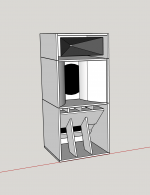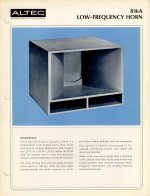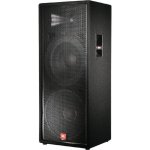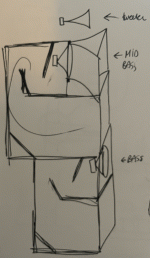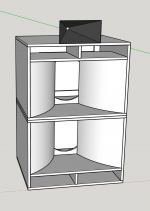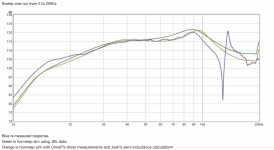Hello everybody: here I am to propose my first diy audio project. I am very intrigued in the acoustic amplification of sound and want to check out for myself if I can make an upgrade to a system I already have. Some background information: I am an engineer-architecture student with good carpentry skills (furniture-making), a very basic knowledge about electronics and a low budget 🙂. I am equally concerned about the looks of the project as I am concerned about its performance (that's just how architects are... 🙂 ).
As I am on a low budget, I want to work with the things I already have in my posession
-Amplifier: American Audio VLP1500 2x500W RMS into 8 Ohm
-Equalizer: Behringer
-Speakers: JBL JRX125 passive speakers (2.5-way system; Frequency Range (-10 dB):2 35 Hz - 16 kHz; Frequency Response (±3 dB):2 45 Hz - 12 kHz)
So what I plan to do is upgrading this setup by only working on the cabinets (I will keep and use all drivers and the crossover), and I would want to do this by introducing acoustic horns into the cabinets. The JRX125 design is super basic, it is just the compression driver and woofers mounted in a hollow cabinet that fits al three.
Here are some things that I think you should know:
-size doesn't matter (I will make multiplex cabinets from scratch and they can be as big as they need to be)
-I have an equalizer so the system itself doesn't need to be tuned perfectly
-I want the system to be LOUD, not especially good sounding; the components I have available are not high quality so I don't expect them to be super loud or good sounding but I want to see how far I can take it with the cabinet design
The speakers are a 2-way, almost 3-way design; in the images I included a scheme of the crossover which is basically a HP filter @ 2kHz for the compression driver, a LP filter @ 2kHz for the first woofer and a LP filter @ about 350Hz for the second woofer (JBL doesn't give exact values in their spec sheet so I tested this just by hearing).
-the compression driver is a JBL 2412, 1" exit compression driver (mounted on a JBL Progressive Transition™ Waveguide)
-the woofers are both JBL M115-8A 15" woofers
So I think I would design this setup as a three-way system with
-one 15" JBL M115-8A woofer LP filtered at 350 for the bass cabinet
-one 15" JBL M115-8A woofer LP filtered at 2 kHz as a midbass cabinet
-the 1" JBL 2412 compression driver for the high notes
In the image in the attachment I suggest how this could look like (note: this is just a quick sketch I made on top of a cubo15 sketchup file, nothing serious), I have been inspired by DIY soundsystems for dub and reggae music as they also have to be cheap and loud with a lot of bass.
Now come my specific questions:
-BASS: can I just download a cabinet design for a 15" folded horn bass cabinet and use this for my M115 driver? https://freespeakerplans.com/plans offers these free building plans with some suggested drivers, I dont find any specifically made for my cheap driver so I would have to use a plan not specifically made for mine. If not, which values of my driver should I compare to the driver used in the example project? Could I lower the frequency output of my speakers by using a more efficient cabinet design than the standard 'dumb box'?
-MIDBASS: as the frequency of the second driver goes from about 40Hz up to 2kHz I was looking to make a frontloaded horn with bass-reflex, similar to that one of the ALTEC 816. Is this a good idea? By the way how comes that these front loaded horns partially cover the driver (see in picture)?
-HIGH: the JBL 2412 compression driver comes with a standard JBL Progressive Transition™ Waveguide, can I make an upgrade for this? Is there a DIY way or another waveguide that I could buy that would make the electricity-to-sound efficiency even higher than it is with the standard? A bigger waveguide, or an exponential horn? Maybe a multicell horn?
I hope my intentions are clear, any replies would be of great help!
As I am on a low budget, I want to work with the things I already have in my posession
-Amplifier: American Audio VLP1500 2x500W RMS into 8 Ohm
-Equalizer: Behringer
-Speakers: JBL JRX125 passive speakers (2.5-way system; Frequency Range (-10 dB):2 35 Hz - 16 kHz; Frequency Response (±3 dB):2 45 Hz - 12 kHz)
So what I plan to do is upgrading this setup by only working on the cabinets (I will keep and use all drivers and the crossover), and I would want to do this by introducing acoustic horns into the cabinets. The JRX125 design is super basic, it is just the compression driver and woofers mounted in a hollow cabinet that fits al three.
Here are some things that I think you should know:
-size doesn't matter (I will make multiplex cabinets from scratch and they can be as big as they need to be)
-I have an equalizer so the system itself doesn't need to be tuned perfectly
-I want the system to be LOUD, not especially good sounding; the components I have available are not high quality so I don't expect them to be super loud or good sounding but I want to see how far I can take it with the cabinet design
The speakers are a 2-way, almost 3-way design; in the images I included a scheme of the crossover which is basically a HP filter @ 2kHz for the compression driver, a LP filter @ 2kHz for the first woofer and a LP filter @ about 350Hz for the second woofer (JBL doesn't give exact values in their spec sheet so I tested this just by hearing).
-the compression driver is a JBL 2412, 1" exit compression driver (mounted on a JBL Progressive Transition™ Waveguide)
-the woofers are both JBL M115-8A 15" woofers
So I think I would design this setup as a three-way system with
-one 15" JBL M115-8A woofer LP filtered at 350 for the bass cabinet
-one 15" JBL M115-8A woofer LP filtered at 2 kHz as a midbass cabinet
-the 1" JBL 2412 compression driver for the high notes
In the image in the attachment I suggest how this could look like (note: this is just a quick sketch I made on top of a cubo15 sketchup file, nothing serious), I have been inspired by DIY soundsystems for dub and reggae music as they also have to be cheap and loud with a lot of bass.
Now come my specific questions:
-BASS: can I just download a cabinet design for a 15" folded horn bass cabinet and use this for my M115 driver? https://freespeakerplans.com/plans offers these free building plans with some suggested drivers, I dont find any specifically made for my cheap driver so I would have to use a plan not specifically made for mine. If not, which values of my driver should I compare to the driver used in the example project? Could I lower the frequency output of my speakers by using a more efficient cabinet design than the standard 'dumb box'?
-MIDBASS: as the frequency of the second driver goes from about 40Hz up to 2kHz I was looking to make a frontloaded horn with bass-reflex, similar to that one of the ALTEC 816. Is this a good idea? By the way how comes that these front loaded horns partially cover the driver (see in picture)?
-HIGH: the JBL 2412 compression driver comes with a standard JBL Progressive Transition™ Waveguide, can I make an upgrade for this? Is there a DIY way or another waveguide that I could buy that would make the electricity-to-sound efficiency even higher than it is with the standard? A bigger waveguide, or an exponential horn? Maybe a multicell horn?
I hope my intentions are clear, any replies would be of great help!
Attachments
By the way how comes that these front loaded horns partially cover the driver (see in picture)?
If the throat of the horn were the same size as the driver then the mouth would have to be huge?
EDIT: I've put a question mark on that! 🙂
Last edited:
In the first image you have a bass horn at the bottom and a mid/bass horn in the middle. This makes aesthetic sense but may create some challenges in the 2.5way configuration.
1. If the lower bass is dependent on the two playing together, and one produces deeper bass and one doesn't, the system will now begin to roll off where the upper one begins to. If you equalise it, you'll be bringing up the level of the deeper one and the headroom will now be reduced.
2. If you use cabinets with different lower bass profiles for the two woofers in a 2.5 way system, they may be out of phase and partially cancel each other.
1. It reduces the sound wanting to bounce off the sides of the horn, more of it goes straight,
2. It raises the higher frequency capability,
3. It restricts the driver (as with a compression driver)
1. If the lower bass is dependent on the two playing together, and one produces deeper bass and one doesn't, the system will now begin to roll off where the upper one begins to. If you equalise it, you'll be bringing up the level of the deeper one and the headroom will now be reduced.
2. If you use cabinets with different lower bass profiles for the two woofers in a 2.5 way system, they may be out of phase and partially cancel each other.
Perhaps three reasons...By the way how comes that these front loaded horns partially cover the driver
1. It reduces the sound wanting to bounce off the sides of the horn, more of it goes straight,
2. It raises the higher frequency capability,
3. It restricts the driver (as with a compression driver)
Thank you for replying! That makes totally sense to me as a different horn length of the two will indeed impose a different delay on both bass producing units. So logically I would need to have two horns that are the same but that is not ideal for either the midbass woofer if I make two bass horns (they are not usable for higher frequencies) and also not ideal for the bass woofer if I were to make two midbass horns (they are not efficient for the lower frequency).In the first image you have a bass horn at the bottom and a mid/bass horn in the middle. This makes aesthetic sense but may create some challenges in the 2.5way configuration.
1. If the lower bass is dependent on the two playing together, and one produces deeper bass and one doesn't, the system will now begin to roll off where the upper one begins to. If you equalise it, you'll be bringing up the level of the deeper one and the headroom will now be reduced.
2. If you use cabinets with different lower bass profiles for the two woofers in a 2.5 way system, they may be out of phase and partially cancel each other.
Perhaps three reasons...
1. It reduces the sound wanting to bounce off the sides of the horn, more of it goes straight,
2. It raises the higher frequency capability,
3. It restricts the driver (as with a compression driver)
1) Would there be an ideal way where I design it this way
-for the bass driver that is low passed at 350 Hz: a backloaded bass horn
-for the midbass driver that is low passed at 2kHz: a backloaded bass horn (same bass profile as the one above) and a frontloaded horn on the same driver that amplifies the mids?
2) Or are you suggesting I should move the midbass horn to the back relatively to the lower bass cabinet so that the delay is solved in their distance so that BASSHORNlength = MIDBASSHORNlength + relative distance
The simple solution would be to drop the 2.5 way and make it a 3 way.
Your problem is not delay, it is phase. That may sound confusing as they are related, but they will have different responses.
I hope you don't overthink this and talk yourself out of something good.. but sometimes the compromise makes sense when you understand the reason you want each horn.
Your problem is not delay, it is phase. That may sound confusing as they are related, but they will have different responses.
I hope you don't overthink this and talk yourself out of something good.. but sometimes the compromise makes sense when you understand the reason you want each horn.
Thanks again for the quick reply,The simple solution would be to drop the 2.5 way and make it a 3 way.
Your problem is not delay, it is phase. That may sound confusing as they are related, but they will have different responses.
I hope you don't overthink this and talk yourself out of something good.. but sometimes the compromise makes sense when you understand the reason you want each horn.
I have already thought of making it 3 way, by making some adjustments on the crossover, but I would prefer not to do that as I want to be able to put the speaker components back in their original cabinets as they will be way more compact.
I understand what phase is, I'm sorry for using the wrong terms I am not a native English speaker.
Don't you think there lies a solution in choosing a back loaded horn design for a bass speaker (let's say a super scooper for example) for both drivers and to make frontal horn flares for the one that also emits mid frequencies?
Thank you in advance!
Maybe.. but phase changes when you change the response and that's what you'll do. I wouldn't expect the old crossover to work the same with the horns.
When I started with horns I built just one kind at a time and found out how to get it to work and learned what to do to improve it. It can get quite involved otherwise.
When I started with horns I built just one kind at a time and found out how to get it to work and learned what to do to improve it. It can get quite involved otherwise.
The old cross over is very simple, that's another reason why I want to keep it. Just a HPF for the compression driver and two different LPFs for the woofers. So from that logic I tried to conceive the horn design: a midbass horn and a bass horn. What difficulties do you refer to? As I said before the project is more an experiment to me how I can make the speakers louder by only using wood to make a more efficient cabinet design. So for me a problem would be to have phase cancellation, but poor sound quality due to uneven amplification of different parts of the sound spectrum is less of a problem to me.Maybe.. but phase changes when you change the response and that's what you'll do. If you think you can use the old crossover to work with the horns, you may run into difficulty.
(I am planning another project with a friend where I will work on crossovers and all that but on a way smaller scale in a portable speaker.)
Is the simple crossover a good thing? Have you considered a back loaded horn for both bass drivers and leave them direct radiating at the front?The old cross over is very simple, that's another reason why I want to keep it.
Because at this point I am quite new to all of this so I like to focus on one thing at a time to not overcomplicate it all 🙂
What you suggest is making for example two super scoops or hog scoops, and for the midrange frequencies just count on the direct radiation that is emitted by the speaker driver? Yes I have considered but I was trying to find a cabinet design solution that could also have flares for the speaker that is low passed at the higher frequency (2kHz) to amplify the higher frequencies as well, as the back loaded horn would only be useful for frequencies of mostly a couple hundred hertz. I'll add a quick sketch of what I mean: (problem not solved at all but gives a general idea)
What you suggest is making for example two super scoops or hog scoops, and for the midrange frequencies just count on the direct radiation that is emitted by the speaker driver? Yes I have considered but I was trying to find a cabinet design solution that could also have flares for the speaker that is low passed at the higher frequency (2kHz) to amplify the higher frequencies as well, as the back loaded horn would only be useful for frequencies of mostly a couple hundred hertz. I'll add a quick sketch of what I mean: (problem not solved at all but gives a general idea)
Attachments
That's what I've been very much trying to do 🙂Because at this point I am quite new to all of this so I like to focus on one thing at a time to not overcomplicate it all 🙂
Let me try something.. I've understood your intention, and your planned method of achieving it, and your stated limits, from the start. I've outlined some issues.
Feel free to add or ask questions...
Last edited:
Yes and thank you for that! It was very good you pointed out I could have phase cancellation, I had completely overseen that.
you stated two problems I could face because of the 2.5way:
"
1. If the lower bass is dependent on the two playing together, and one produces deeper bass and one doesn't, the system will now begin to roll off where the upper one begins to. If you equalise it, you'll be bringing up the level of the deeper one and the headroom will now be reduced.
2. If you use cabinets with different lower bass profiles for the two woofers in a 2.5 way system, they may be out of phase and partially cancel each other.
"
What do you think is the most feasible and will produce the best bass and loudest overal sound:
1. create no lower bass profile horn for the upper woofer and make a frontal horn with flares for amplifying the mids of that driver, and an only make a bass horn for the lower woofer that is going up to 350 Hz, thereby only counting on the bass radiation of the latter one
->will the direct radiation of the front of the upper woofer interfere with the bass production of the lower one, causing it to sound bad or more quiet, or will this low frequence radiation be neglectable because it is not amplified by a horn and thereby way less loud?
2. create two backloaded bass horns for both drivers with the drivers faced frontally to the listener
->is it possible to amplify the higher frequencies up to 2kHz that the upper woofer is emitting by putting flares in front of it to create a horn effect? It just seems weird to me to make two cabinets that are exactly the same for those two drivers because one is going from 40 to 350Hz and the other from 40 to 2kHz, that's why I am talking about adding those flares
you stated two problems I could face because of the 2.5way:
"
1. If the lower bass is dependent on the two playing together, and one produces deeper bass and one doesn't, the system will now begin to roll off where the upper one begins to. If you equalise it, you'll be bringing up the level of the deeper one and the headroom will now be reduced.
2. If you use cabinets with different lower bass profiles for the two woofers in a 2.5 way system, they may be out of phase and partially cancel each other.
"
What do you think is the most feasible and will produce the best bass and loudest overal sound:
1. create no lower bass profile horn for the upper woofer and make a frontal horn with flares for amplifying the mids of that driver, and an only make a bass horn for the lower woofer that is going up to 350 Hz, thereby only counting on the bass radiation of the latter one
->will the direct radiation of the front of the upper woofer interfere with the bass production of the lower one, causing it to sound bad or more quiet, or will this low frequence radiation be neglectable because it is not amplified by a horn and thereby way less loud?
2. create two backloaded bass horns for both drivers with the drivers faced frontally to the listener
->is it possible to amplify the higher frequencies up to 2kHz that the upper woofer is emitting by putting flares in front of it to create a horn effect? It just seems weird to me to make two cabinets that are exactly the same for those two drivers because one is going from 40 to 350Hz and the other from 40 to 2kHz, that's why I am talking about adding those flares
I am still searching for solutions, I just found out the JBL m115-8a drivers have an MMS of only 53 grams which is pretty low compared to other drivers. How do I take that into account choosing a horn design?That's what I've been very much trying to do 🙂
Let me try something.. I've understood your intention, and your planned method of achieving it, and your stated limits, from the start. I've outlined some issues.
Feel free to add or ask questions...
Greetings Jules
The block I keep running up against is the crossover. To keep up the conversation I'm going to have to overlook that aspect.
You want to run a midbass horn down below it's cutoff. Horns are often crossed above instead due to their behaviour at cutoff. You may want to check this with a hornresp sim, for example group delay. If it happens at a low enough frequency you may find it less of an audible problem. You can get a similar conflict with back loaded horns cutting in at their top end but you can simulate those also, to manage it.
You want to run a midbass horn down below it's cutoff. Horns are often crossed above instead due to their behaviour at cutoff. You may want to check this with a hornresp sim, for example group delay. If it happens at a low enough frequency you may find it less of an audible problem. You can get a similar conflict with back loaded horns cutting in at their top end but you can simulate those also, to manage it.
You may bild 500 litres box tuned 45 Hz 😎 .Could I lower the frequency output of my speakers by using a more efficient cabinet design than the standard 'dumb box'?
You may search horn project for Qtc .4 drivers.
Horn + BR + backloaded horn for .5-way IMO is bad idea, AllenB already explained why. Architector\engineer should not build such things. Even visual designer should not. Except sound doesn't matter.
A lot of this in inet. Acoustic difference seems obvious (or no?)) even in the photo.DIY soundsystems for dub and reggae music
Ok, make two backloads with M115, leave the tweeter\waveguide as is and add some mid, in front horn as you like horns. It may be some BaByDuBy))
Don't forget the crossover!))
Last edited:
This type of system is always run active and usualy with DSP crossover due to the complexity of making a workable passive crossover (not the mention the acoustic path length differences). You can get integrated DSP amplifiers from Sanway, Gisen etc. at reasonable cost that would allow you to run the whole system mono from a single amp. I would expect with the basic low complexity passive XO in the JBLs massive improvement in sound quality is possible with a correctly implemented active crossover. Then in terms of adding extra bass you would be better served by just adding dedicated subs using your remaining amp channel to your existing speaker. For a low cost huge design look up the quad JBL devastator design.
Thank you for this answer! I totally forgot about a DSP crossover, this would be ideal as I won't have to be messing with the original passive crossover and potentially mess it up... I think I have found a solution that would satisfy my needs, it would consist of a 2 phase plan:This type of system is always run active and usualy with DSP crossover due to the complexity of making a workable passive crossover (not the mention the acoustic path length differences). You can get integrated DSP amplifiers from Sanway, Gisen etc. at reasonable cost that would allow you to run the whole system mono from a single amp. I would expect with the basic low complexity passive XO in the JBLs massive improvement in sound quality is possible with a correctly implemented active crossover. Then in terms of adding extra bass you would be better served by just adding dedicated subs using your remaining amp channel to your existing speaker. For a low cost huge design look up the quad JBL devastator design.
Phase 1: make cabinets for the drivers that I already have that are made for their frequency response +-3dB (45-16000Hz), I am looking a lot at old ALTEC LANSING building plans as they are really clear and they are often used for 2-way systems where a midlow frontloaded horn with bass reflex stands in for the mids and lows and a tweeter with multicell horn stands in for the higher tones. The ALTEC 816a for example states 'the front loading horn element loads the bass driver down to 200Hz, while the bass reflex porting extends the useful response to 50Hz (ideal for my woofers, no?), also their drivers used in this model are 15" and their MMS is also just over 50 grams which makes replicating these cabinets for my drivers more easily. I might recalculate the cabinet volume and port dimensions using software to adapt it to my particular JBL m115-8a drivers, but I would keep the design concept of the Altec 816a's, does that make sense?
Phase 2 (and this is where your reply comes in handy): I have now two pairs of midlow cabinets for my 4 woofers, and the compression drivers with their original waveguides on top of them, now I can make an upgrade to this system that focusses on loud and low bass by making for example this JBL devastator. With the one amp that I have I will indeed make it mono but that's okay for loud and boomy parties I guess 🙂. I would digitally crossover between the midlow cabinets and the external subwoofer at around 200Hz (that is what the JBL devastator is designed for and this also keeps the frontloaded part of the horns of my cabinets in use: see the citation from Altec in previous paragraph). Then my VLP1500 amp which is rated at
675W RMS Per Channel and 4 Ohms and 450W RMS Per Channel @ 8 Ohms coms in use: the amp that was used for the JBL devastator was 1000W at 4 Ohms so I would be getting 675W from one channel for that; my speakers of 8 Ohms each will be coupled in parallell to the other channel, and thus also profit 675W due to the lower resistance.
Now again some questions:
-Does this all make sense? Keep in mind that I want to keep things cheap and reversible. I also don't need premium sound quality, just not garbage.
-The JBL devastator makes a huge drop @ around 130Hz (image in attachment) but nobody in the thread seems to care about that, is this not a problem?
-I really like the idea of using those crazy cheap and powerfull car subwoofers for these kind of DIY projects, in what way is sound quality compromized compared to using a conventional subwoofer of the same power rating that's always way more expensive?
-Can I assume the devastator will also make nice bass with my 675W instead of the original 1000W?
-I am right that parallel coupling those two 8 Ohm speakers in parallel will result in a 4 Ohm resistance due to Ohm's law, so that they will also profit from the 675W?
Thanks again for your suggestions!
Attachments
Last edited:
Thanks for your reply! have a look at my elaborated reply on kipman725's post, in there I took everybodies tips and suggestions into account. I think I'm making some improvements on conceiving this problem but I still have enough questions 🙂; by the way, I like the collage you made for me!View attachment 1116864
You may bild 500 litres box tuned 45 Hz 😎 .
You may search horn project for Qtc .4 drivers.
Horn + BR + backloaded horn for .5-way IMO is bad idea, AllenB already explained why. Architector\engineer should not build such things. Even visual designer should not. Except sound doesn't matter.
A lot of this in inet. Acoustic difference seems obvious (or no?)) even in the photo.
Ok, make two backloads with M115, leave the tweeter\waveguide as is and add some mid, in front horn as you like horns. It may be some BaByDuBy))
View attachment 1116871
Don't forget the crossover!))
Thanks for your reply! have a look at my elaborated reply on kipman725's post, in there I took everybodies tips and suggestions into account. I think I'm making some improvements on conceiving this problem but I still have enough questions 🙂The block I keep running up against is the crossover. To keep up the conversation I'm going to have to overlook that aspect.
You want to run a midbass horn down below it's cutoff. Horns are often crossed above instead due to their behaviour at cutoff. You may want to check this with a hornresp sim, for example group delay. If it happens at a low enough frequency you may find it less of an audible problem. You can get a similar conflict with back loaded horns cutting in at their top end but you can simulate those also, to manage it.
I own a pair of JRX115's which are the single bass driver version of your speaker. Firstly the bass units in the speakers are very good, you should expect decent sound quality from them.
Lots of people on the web suggest a selenium compression driver as an upgrade to the original jbl driver. I don't have a problem with the original, it's not as good as my Beymas or my BMS CD's but for home use it isn't 'awful'. For pro (loud) use maybe an upgrade is worthwhile.
I'd suggest rebuilding the cabs with decent quality ply, some bracing, and a bit of damping on the enclosure walls. Might be worth measuring the original cabs / ports and modelling them to see if bigger ports are needed. I know my cabs are ported quite high so as you have EQ it could be worth looking at a lower tuning frequency and slightly bigger cabs.
Personally, I would not bother trying to horn load the 15's.
Rob.
Selenium D210Ti (not sure if it's discontinued)
Lots of people on the web suggest a selenium compression driver as an upgrade to the original jbl driver. I don't have a problem with the original, it's not as good as my Beymas or my BMS CD's but for home use it isn't 'awful'. For pro (loud) use maybe an upgrade is worthwhile.
I'd suggest rebuilding the cabs with decent quality ply, some bracing, and a bit of damping on the enclosure walls. Might be worth measuring the original cabs / ports and modelling them to see if bigger ports are needed. I know my cabs are ported quite high so as you have EQ it could be worth looking at a lower tuning frequency and slightly bigger cabs.
Personally, I would not bother trying to horn load the 15's.
Rob.
Selenium D210Ti (not sure if it's discontinued)
Last edited:
- Home
- Loudspeakers
- Multi-Way
- DIY project: acoustic upgrades to an existing speaker (horns & cabinet design)
